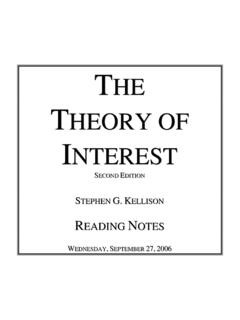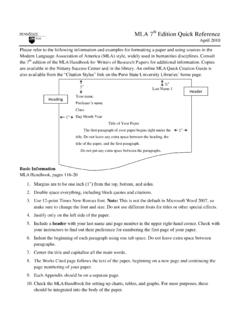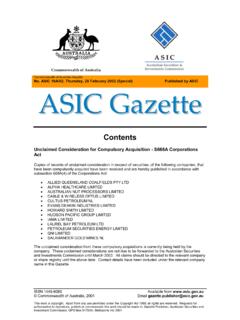Transcription of That's the Joint!: The Hip-Hop Studies Reader
1 THaT STHE JOInt!RT9190_C00a_i-xvi 8/5/04 3:20 PM Page iiROUTLEDGENew York LondonTHaT STHE JOInt!The Hip-Hop Studies ReaderMurray Forman & Mark Anthony NealEDITORSP ublished in 2004 by Routledge270 Madison AvenueNew York, NY in Great Britain byRoutledge2 Park Square Milton Park, Abingdon Oxfordshire OX14 is an imprint of the Taylor & Francis Group. 2004 by Taylor & Francis Books, in the United States of America on acid free : Jack Donner, rights reserved. No part of this book may be reprinted or reproduced or utilized in anyform or by any electronic, mechanical or other means, now known or hereafter invented,including photocopying and recording or in any information storage or retrieval system,without permission in writing from the 9 8 7 6 5 4 3 2 1 Library of Congress Cataloging-in-Publication DataThat's the joint! : the Hip-Hop Studies Reader / edited by Mark Anthony Neal and murray bibliographical references and 0-415-96918-2 (hardback : alk.)
2 Paper) ISBN 0-415-96919-0 (pbk. : alk. paper) 1. Rap (Music) History and criticism. 2. Rap (Music) Social aspects. 3. Neal, Mark Anthony. II. Forman, murray , 1959- 2004 '09 dc22 2004015140 RT9190_C00a_i-xvi 8/5/04 3:20 PM Page ivDedicated to the memory ofJason Jam Master Jay Mizzel, 8/5/04 3:20 PM Page vRT9190_C00a_i-xvi 8/5/04 3:20 PM Page viForewordxiAcknowledgmentsxvIntroductio n1 murray FORMANPart IHip-Hop Ya Don t Stop:9 Hip-Hop History and HistoriographyMURRAY FORMAN1 Breaking13 SALLY BANES2 The Politics of Graffiti21 CRAIG CASTLEMAN3 Breaking: The History31 MICHAEL HOLMAN4B-Beats Bombarding Bronx: Mobile DJ Starts Something 41with Oldie R&B DisksROBERT FORD, Talking DJs Rapping Away in Black Discos 43 ROBERT FORD, s Founding Fathers Speak the Truth 45 NELSON GEORGEviiContentsRT9190_C00a_i-xvi 8/5/04 3:20 PM Page viiPart IINo Time for Fake Niggas: Hip-Hop Culture 57and the Authenticity DebatesMARK ANTHONY NEAL7 The Culture of Hip-Hop61 MICHAEL ERIC DYSON8 Puerto Rocks.
3 Rap, Roots, and Amnesia69 JUAN FLORES9It s a Family Affair87 PAUL GILROY10 Hip-Hop Chicano: A Separate but Parallel Story95 RAEGAN KELLY11On the Question of Nigga JUDY12 Looking for the Real Nigga: Social Scientists Construct the Ghetto119 ROBIN KELLEY13 About a Salary or Reality? Rap s Recurrent Conflict137 ALAN LIGHT14 The Rap on Rap: The Black Music that Isn t Either147 DAVID SAMUELSPart III Ain t No Love in the Heart of the City:155 Hip-Hop , Space, and PlaceMURRAY FORMAN15 Black Empires, White Desires:159 The Spatial Politics of Identity in the Age of Hip-HopDAVARIAN L. BALDWIN16 Hip-Hop am Main, Rappin on the Tyne: Hip-Hop Culture as a 177 Local Construct in Two European CitiesANDY BENNETT17 Represent : Race, Space, and Place in Rap Music 201 murray FORMAN18 Rap and Hip-Hop : The New York Connection223 DICK HEBDIGE19 Uptown Throwdown233 DAVID TOOP viii CONTENTSRT9190_C00a_i-xvi 8/5/04 3:20 PM Page viiiPart IVI ll Be Nina Simone Defecating on Your Microphone:247 Hip-Hop and GenderMARK ANTHONY NEAL20 Translating Double-Dutch to Hip-Hop :251 The Musical Vernacular of Black Girls PlayKYRA D.
4 GAUNT21 Empowering Self, Making Choices, Creating Spaces:265 Black Female Identity via Rap Music PerformanceCHERYL L. KEYES22 Hip-Hop Feminist277 JOAN MORGAN23 Seeds and Legacies: Tapping the Potential in Hip-Hop283 GWENDOLYN D. POUGH24 Never Trust a Big Butt and a Smile291 TRICIA ROSEPart VThe Message: Rap, Politics, and Resistance307 MARK ANTHONY NEAL25 Organizing the Hip-Hop Generation311 ANGELA ARDS26 Check Yo Self Before You Wreck Yo Self:325 The Death of Politics in Rap Music and Popular CultureTODD BOYD27 The Challenge of Rap Music from Cultural Movement 341to Political PowerBAKARI KITWANA28 Rap, Race, and Politics351 CLARENCE LUSANE29 Postindustrial Soul: Black Popular Music at the Crossroads363 MARK ANTHONY NEALPart VILooking for the Perfect Beat:389 Hip-Hop Aesthetics and Technologies of ProductionMURRAY FORMAN30 Airshafts, Loudspeakers, and the Hip Hop Sample:393 Contexts and African American Musical AestheticsANDREW BARTLETTCONTENTS ixRT9190_C00a_i-xvi 8/5/04 3:20 PM Page ix31 Public Enemy Confrontation407 MARK DERY32 Hip-Hop .
5 From Live Performance to Mediated Narrative421 GREG DIMITRIADIS33 Sample This437 NELSON GEORGE34 This Is a Sampling Sport : Digital Sampling,443 Rap Music, and the Law in Cultural ProductionTHOMAS G. SCHUMACHER35 Challenging Conventions in the Fine Art of Rap459 RICHARD SHUSTERMAN36 Hip-Hop and Black Noise: Raising Hell481 RICKEY VINCENTPart VIII Used to Love :493 Hip-Hop in/and the Culture IndustriesMARK ANTHONY NEAL37 Commercialization of the Rap Music Youth Subculture497M. ELIZABETH BLAIR38 Dance in Hip-Hop Culture505 KATRINA HAZZARD-DONALD39 Wendy Day, Advocate for Rappers517 NORMAN KELLEY40 The Business of Rap: Between the Street and the Executive Suite525 KEITH NEGUS41 Contracting Rap: An Interview with Carmen Ashhurst-Watson541 TRICIA ROSE42 Black Youth and the Ironies of Capitalism557S. CRAIG WATKINS43 Homies in The Hood: Rap s Commodification of Insubordination579 TED SWEDENBURG44An Exploration of Spectacular Consumption:593 Gangsta Rap as Cultural CommodityERIC K.
6 WATTSP ermissions611 Index615x CONTENTSRT9190_C00a_i-xvi 8/5/04 3:20 PM Page x Sir, please turn around and face me, the airport security employee directed me. As Icomplied, he continued to methodically search me at the security checkpoint. He remindedme of my son, a tall taffy-faced figure who d barely left his youth behind. As I caught his eyeswhen he frisked my outstretched arms, he whispered to me while keeping his professionaldemeanor. Man, I really feel your work on Pac, he gently stated, referring to my book Holler If You HearMe: Searching for Tupac Shakur. Plus, I ve seen Thug Angeland Tupac Vs. two documentarieson the slain rapper in which I d participated and you be puttin it down. May I please place my hands on your chest since my detector went off? he quizzed memore formally without missing a beat. Sure, no problem, I replied. That s where mysuspenders are. And I m glad you like the work.
7 Fo sho, fo sho , he said as he effortlesslyslid back into his vernacular voice. I m just glad to know that somebody from your generationcares about Pac and Hip-Hop , and takes the time to listen to what we re saying. Alright, sir, I m finished. You re done. But could you do me a big favor? What s that? I young man retreated to a portable booth tucked away at the end of the security lineand fetched a dog-eared paperback copy of my book. If you don t mind, please sign this beforeyou go. I was moved by his heartfelt compliments. I was even more touched by his eloquent rebukeof the view that his generation is illiterate and wholly fixed on destruction and mindless mate-rialism. We weren t in school, and he wasn t reading my book for a good grade or for extracredit. Like the best students, he read for passion, and for the pleasure and pursuit of criticalstimulation. It seemed that he was hungry for a sign among intellectuals and older folk that thehuge importance of Hip-Hop hadn t been smothered by contempt, or just as bad, squanderedby undiscriminating enthusiasm.
8 And his delight in me taking Tupac seriously was anunspoken nod to the fierce crosswinds in which Hip-Hop is presently caught. There are somewho dismiss Hip-Hop as the dead letter of brazen stereotype-mongering among the severelyundereducated and their gaggle of learned and over-interpreting defenders. Other critics claimthat the deficits of Hip-Hop are amplified because they blare beyond the borders of ugly art toinspire youth to even uglier behavior. And others protest that, stripped of politics, history, andracial conscience, Hip-Hop is little more than sonic pathology that blasts away all the achieve-ment of the civil rights 8/5/04 3:20 PM Page xiThe academic study of Hip-Hop like Hip-Hop itself has been the subject of complaintseven from its earliest days. By now, many of the complaints are familiar, even tired. But thathasn t stopped their being repackaged every so often to track the sensational headlines thattrumpet the moral transgressions or violent deaths that rattle the rap world.
9 John McWhorter,who s made a career in the public arena by twisting anecdotes of perceived black misbehaviorinto a questionable analysis of contemporary race, eloquently weighs in with lopsided moral-izing in the summer 2003 issue ofCity Journal. By reinforcing the stereotypes that longhindered blacks, McWhorter argues, and by teaching young blacks that a thuggish adversarialstance is the properly authentic response to a presumptively racist society, rap retards blacksuccess. That s an awfully big burden to carry the fate of black success especially for blackyouth (at least the ones who make a cameo in the anecdote that fronts McWhorter s essay)who appear to McWhorter to embody the antisocial behavior encouraged by hardcore rap thatpreaches bone-deep dislike of authority. Many critics, including McWhorter, don t account for the complex ways that some hip-hopartists play with stereotypes to either subvert or reverse them.
10 For instance, amidst all the pimpmythologies and metaphors that weigh heavily on branches of contemporary Hip-Hop , rapperslike Common seize on pimpology s prominence to poke fun at its pervasiveness. But its criticsoften fail to acknowledge that Hip-Hop is neither sociological commentary nor political criti-cism, though it may certainly function in these modes through its artists lyrics. Hip-Hop isstill fundamentally an art formthat traffics in hyperbole, parody, kitsch, dramatic license,double entendres, signification, and other literary and artistic conventions to get its pointsacross. By denying its musical and artistic merit, Hip-Hop s critics get to have it both ways: theycan deny the legitimate artistic standing of rap while seizing on its pervasive influence as an artform to prove what a terrible affect it has on youth. There are few parallels to this heavy-handed wrong-headedness in the criticism of other art forms like films, plays, or visual art,especially when they are authored by non-blacks.

















